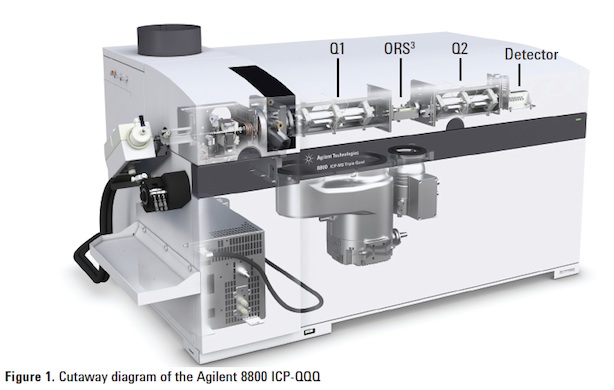Agilent 8800 ICP-QQQ Application Handbook
Introduction to the Agilent 8800
Triple Quadrupole ICP-MS
The ground-breaking Agilent 8800 ICP-QQQ is the world’s first Triple Quadrupole ICP-MS, representing a major advance in ICP-MS technology and redefining performance for trace element analysis. By taking the proven technology of Agilent’s 7700 Series quadrupole ICP-MS and adding the unique power of MS/MS operation, the 8800 ICP-QQQ delivers unmatched analytical capability to handle even the most difficult samples and applications with ease.
Configuration of the
Agilent 8800 ICP-QQQ
The IUPAC definition of a triple quadrupole mass spectrometer (term 538 from the 2013 Recommendations) is "Tandem mass spectrometer comprising two transmission quadrupole mass spectrometers in series, with a (non-selecting) RF-only quadrupole (or other multipole) between them to act as a collision cell."
The cell containing the ion guide — the Octopole Reaction System (ORS3) in the case of the 8800 ICP-QQQ — can be pressurized with a collision or reaction gas to process the ions selected by the first quadrupole (Q1). The resulting product ions that emerge from the cell are then filtered by the second quadrupole (Q2) before being passed to the detector.
ICP-MS/MS technology
The tandem MS configuration of the Agilent 8800 ICP‑QQQ allows unprecedented control over the ions that enter the cell, and therefore ensures consistent reaction processes even when the sample composition varies, a first for ICP-MS. In MS/MS mode, Q1 operates as a unit mass filter, allowing only the ions at a single specific mass to charge ratio (m/z) to enter the collision/ reaction cell. All matrix and non-target analyte ions are excluded, and only the analyte ions and any on‑mass (same m/z) interferences enter the cell.
The means that the reactions in the ORS3 are simpler and more predictable compared to conventional quadrupole ICP-MS where all ions in the sample enter the cell and react, creating new, sample-dependent interferences and overlaps on the target analytes.
The Agilent 8800 ICP-QQQ unlocks the full potential of reaction cell chemistry to remove spectroscopic interferences, delivering greater accuracy and more consistent results even for previously problematic analytes and in complex and variable matrix samples.

